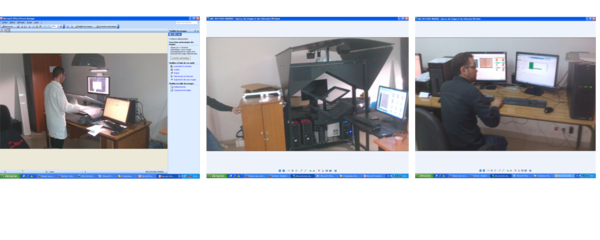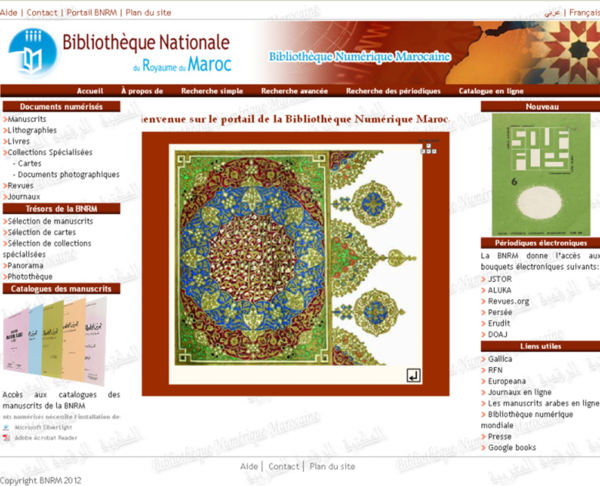Customer testimonial

The NLKM Preserving its National Funds Heritage
The National Library of the Kingdom of Morocco (called “NLKM”) is actively engaged in preserving its national heritage.
This project was created in 2009 with the goal of conserving, restauring, and digitizing all the Moroccan heritage funds, representing 80,000 manuscripts (200,000 titles) of every era since the 9th century, conserved in every Moroccan library (NLKM, heritage libraries, university libraries, public libraries, and private libraries which are open to the public).
Determined and engaged, NLKM has set clear objectives:
- make accessible all francophone content through a digital library ,
- preserve the original manuscripts (deteriorating with public use) ,
- expand its reputation internationally and establish a “temple guardian” reputation ,
- conserve at least one digital copy (in case of a catastrophe),
- digitize all the manuscripts for mid-June 2016.
To reach these goals, NLKM has partnered up with i2S , specialists in image capturing and processing, and with Spigraph (Moroccan agency) to assure a global service. Since the beginning of the project in 2009, i2S has equipped NLKM with a book scanner called CopiBook . Then , to reach a sufficiant production rhythm, NLKM has enlarged its scanner park with CopiBook and DigiBook scanners for works requiring partial opening to scan.
“These scanners are magnificent. They are robust and never break. The i2S scanner collection has allowed us to reach our goals, and in particular digitilize 4,600,000 pages for mid-June 2016” ~ Hassan Aakki, head of Management and Conservation of collections.
Characteristics of the content
Hassan Aakki explains that the content of the manuscripts constitutes the cultural identity and specificity of the Morrocan civilization. Its importance resides in its values such as history, scientific, and arts as it is attractive. Unique works enriched with diagrams, commentaries, and illuminations, these manuscripts treat theology as much as medicine, mathematics, and human science. A large distribution of parchments, tissue, and sheets of papers, in varied formats (between 15 and 31cm), the content of the manuscripts is not only antique but also very fragile. This diversity of writing has pushed reflection on the most adapted digital solution. And naturally, the choice has been set on the CopiBook and DigiBook scanners developed by i2S.
The steps of the digitization process
The digitilizing project started in 2009 with limited resources (a small team and one book scanner). In 2012, thanks to more means and funds, NLKM enlarged its scanners’ park and started to digitize massively, one million pages per year (the equivalent of four thousand volumes). In 2014, the new i2S scanners permitted NLKM to increase its digitizing rhythm, and so reached two million six hundred thousand pages, the equivalent of about seven thousand volumes.
All made at NLKM site
Image capturing is done by the i2S scanners (3 CopiBooks and 1 DigiBook), digitilizing from 300 to 600 dpi in color and saving TIFF format (22 mo per image). Then each image is converted into JPG/PDF and the indexation metadata are added. These digital files are then transferred to the diffusion platform.
“I scan almost 10,000 images each day, in a three eight rhythm” ~ Hassan Aakki.
More than half of the library content is already digitilized and accessible
The digital library of Morocco ( www.bnrm.ma)
NLKM gives access to more than 300,000 pages. Each document is available in different languages: Arabic, Amazigh (Berber alphabet), and French.
About a hundred newspapers have already been digitilized and are available online (for works that are still under rights [1]), in the catalog, and in the digital library (works that are free of rights). The user has direct access to the document in “plain text” (most of the document has been “OCRed”, text recognition), thus offering them the possibility to download a PDF document and print it. The user can also refine research thanks to the metadata index in all the digital documents.
[1] For works that are still under rights: the visitor has the possibility to print a part of the work.
The temple guardian of Moroccan heritage
NLKM was looking to obtain at least one digital copy of every Moroccan heritage manuscript. Thus, to incite private individuals (Moroccan owners of manuscripts) to let their “treasures” become known, each year NLKM organised the Hassan Prize to recompense the best and most beautiful manuscript. Through this competition, the private individuals will bring their manuscripts to NLKM, who will in turn digitize and keep a digital copy (the originals will be returned to their owners). So each year NLKM receives about a hundred manuscripts. not having the authority to keep the manuscripts from citizens, NLKM teaches Moroccans about the preservation of their private heritage and gives them advice (such how to never put manuscripts in direct light and how to protect them from humidity).
International fame and visibility
Today, NLKM has become the head of the country’s library network:
- The web portal Catalogue of Morrocan Libraries gives simple and fast access to the bibliographic reservoir, taking into account all types of documents (scientific, cultural, or legacy)
- RFM Digital francophone network
- World Digital Library
Also, NLKM is also an active member within the international associations and libraries: IFLA (International Federation Library Associations), involvement in universal programs: ISBN, ISSN; publishing trades with the National Library of France.
Finally, it offers services and expertise in library science, digitalization, conservation, and restauration. It also participates in professional training.
The digital Library achieves 40,000 users in 2014
In 2014, the digital library’s visitors originate from numerous African and French countries, with a large majority being Moroccans (72.83% of visitors), along with the French (6,89%), Algerians (5,08%), and also Americans (1,78%), Egyptians (1,49%), etc.
With a margin of exponential progression, from country statistics and thanks to a dynamic collaboration with other networks (RFN, WLD, DPL), the number of visitors keeps growing. In terms of the image and fame, the digital library of Morocco is visible and accessible in all other francophone countries, and shares with the national libraries in France, Tunisia, Luxembourg, etc. The 18 countries of the RFM network are also found, home to 28 institution which feeds the website.











